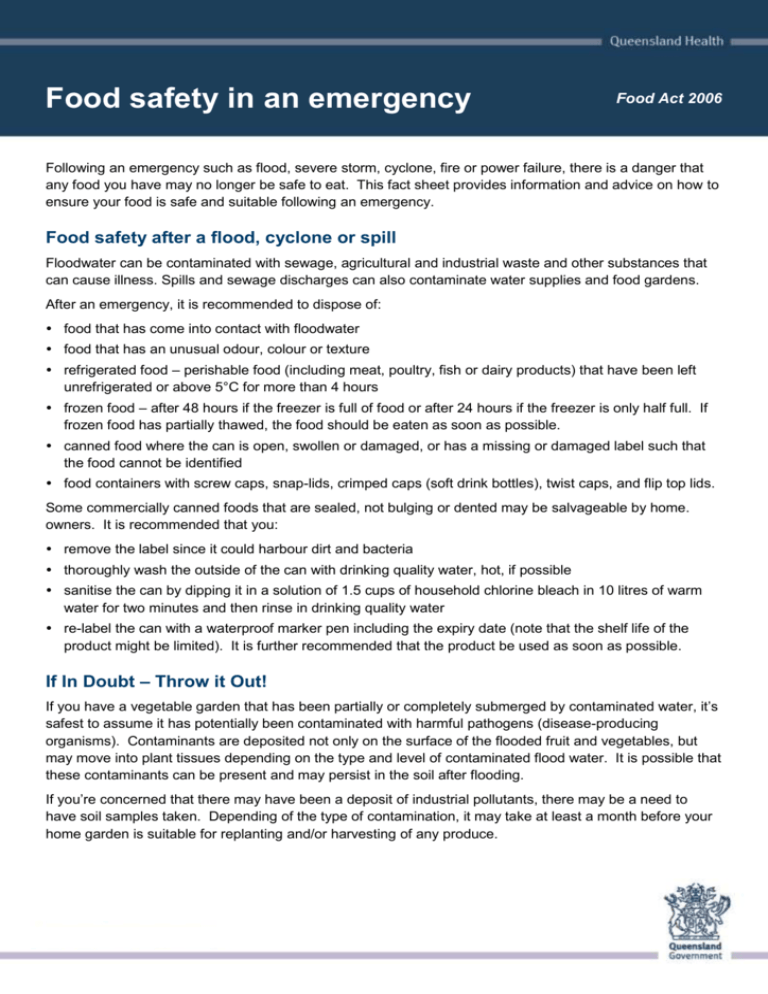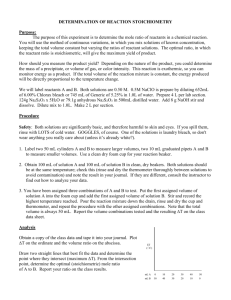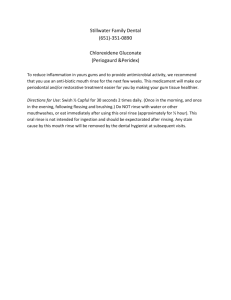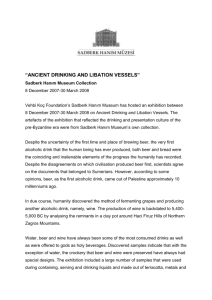Food safety in an emergency
advertisement

Food safety in an emergency Food Act 2006 Following an emergency such as flood, severe storm, cyclone, fire or power failure, there is a danger that any food you have may no longer be safe to eat. This fact sheet provides information and advice on how to ensure your food is safe and suitable following an emergency. Food safety after a flood, cyclone or spill Floodwater can be contaminated with sewage, agricultural and industrial waste and other substances that can cause illness. Spills and sewage discharges can also contaminate water supplies and food gardens. After an emergency, it is recommended to dispose of: food that has come into contact with floodwater food that has an unusual odour, colour or texture refrigerated food – perishable food (including meat, poultry, fish or dairy products) that have been left unrefrigerated or above 5°C for more than 4 hours frozen food – after 48 hours if the freezer is full of food or after 24 hours if the freezer is only half full. If frozen food has partially thawed, the food should be eaten as soon as possible. canned food where the can is open, swollen or damaged, or has a missing or damaged label such that the food cannot be identified food containers with screw caps, snap-lids, crimped caps (soft drink bottles), twist caps, and flip top lids. Some commercially canned foods that are sealed, not bulging or dented may be salvageable by home. owners. It is recommended that you: remove the label since it could harbour dirt and bacteria thoroughly wash the outside of the can with drinking quality water, hot, if possible sanitise the can by dipping it in a solution of 1.5 cups of household chlorine bleach in 10 litres of warm water for two minutes and then rinse in drinking quality water re-label the can with a waterproof marker pen including the expiry date (note that the shelf life of the product might be limited). It is further recommended that the product be used as soon as possible. If In Doubt – Throw it Out! If you have a vegetable garden that has been partially or completely submerged by contaminated water, it’s safest to assume it has potentially been contaminated with harmful pathogens (disease-producing organisms). Contaminants are deposited not only on the surface of the flooded fruit and vegetables, but may move into plant tissues depending on the type and level of contaminated flood water. It is possible that these contaminants can be present and may persist in the soil after flooding. If you’re concerned that there may have been a deposit of industrial pollutants, there may be a need to have soil samples taken. Depending of the type of contamination, it may take at least a month before your home garden is suitable for replanting and/or harvesting of any produce. Cleaning and sanitising After an emergency, it is important to ensure surfaces of benches and food utensils are safe to be used for food handling: carefully check dishes, pots, pans, cutlery and kitchen equipment that might have been in contact with floodwater or other contaminants. throw away any damaged or cracked items, items made from porous material such as wood, plastic or rubber including wooden chopping boards as they cannot be adequately sanitised. wash utensils and surfaces in hot, soapy, drinking quality water. take apart and clean the non-electrical pieces of any kitchen equipment that can be safely disassembled and then rinse in clean, hot water. sanitise silverware, metal utensils, pots, pans and kitchen equipment in pieces by placing them in boiling water for at least 3 minutes. Food dishes and utensils that cannot be safely placed in boiling water – such as certain glassware, porcelain, china and enamelware – should be sanitised by immersing it in a disinfecting solution of 1 tablespoon of chlorine bleach per 2 litres of warm water, then rinsed with drinking quality water before use. clean cupboards and counters with hot soapy water, then rinse with a chlorine bleach solution of 1 tablespoon of chlorine bleach per 2 litres of warm water. Rinse thoroughly with drinking quality water before storing dishes. air dry items if there is any possibility that tea towels might have been splashed with contaminated water. Water for drinking In an emergency, tap water and private water supplies from tanks, wells and bores may become unsafe to drink and use for cooking and cleaning. Residents should monitor public announcements, or contact the local water supplier to determine if tap water is safe to use. Private water supplies should be tested before using again. Guidance on ensuring safe water: use only bottled, boiled or treated water – in that order of preference – for drinking, cooking or preparing food, washing utensils and surfaces, brushing teeth, hand washing, making ice and bathing. filter cloudy water through a clean cloth or allow it to settle and then pour off the clear water for boiling. Boil the water then leave it to cool and store in a clean, covered container. Boiling will ensure water is safe from most types of harmful bugs but will not remove chemical contaminants. advice on the effectiveness of alternative disinfection methods should be sought from suitably qualified professionals. thoroughly clean any containers used to store water with hot soapy drinking quality water, then rinse with a bleach solution of 1 tablespoon of bleach per 2 litres of warm water. Rinse thoroughly with drinking quality water before use. After a fire One of the dangers of a fire can be toxic fumes from burning materials. Chemicals used to fight the fire can also contain toxic materials. After a fire it is recommended to: throw out any food that has been near a fire, including food in cans and jars even if it appears OK throw out any raw food, or food in packaging such as cardboard, plastic wrap, screw-topped jars and bottles Food safety in an emergency -2- throw out food from a refrigerator as the refrigerator may not be airtight and fumes may have entered wash cooking utensils exposed to fire-fighting chemicals in hot soapy water, then sanitise in 1 tablespoon of chlorine bleach per 2 litres of hot water and rinse with drinking quality water before use. After a power failure It is useful to make a note of the time the power failed. Keep it cold! If the power supply is off for more than 4 hours, food in refrigerators can spoil. Keep the refrigerator door closed as much as possible while the power is off. A closed refrigerator should keep food cold for 4 hours. If food that’s meant to be in the refrigerator is allowed to warm for 2 hours or more, avoid eating it. Freezers will usually not defrost and allow food to spoil for at least 24 hours, provided the door has been kept shut. If frozen foods have thawed, they should not be refrozen but should be kept cold and eaten as soon as possible. If you have access to a good supply of ice, it is possible to pack your refrigerator and freezer to help maintain the temperatures of food. Keep it hot! Throw out food that was being cooked when the power failed if cooking cannot be completed properly within 2 hours: if food is already properly cooked, you should ensure it is eaten within 2 hours or thrown out. Remember: If In Doubt – Throw it Out! For further information Queensland Health has a variety of fact sheets with detailed information on food safety. Fact sheets can be accessed from the Queensland Health website at www.health.qld.gov.au. Contact your local government environmental health officer if you have any further questions regarding food safety in an emergency. Contact details can be found at www.dlgp.qld.gov.au/local-governmentdirectory.html or your local White Pages. Food safety in an emergency -3-






